Cadillac CT5 2023 Head Restraints and Rear Seats User Guide
The Cadillac CT5 is a midsize luxury sedan from American automaker Cadillac. The 2023 model year brings several updates and enhancements to the CT5, particularly to its Head Restraints and Rear Seats. Under the hood, the CT5 comes equipped with a 2.0-liter turbocharged four-cylinder engine paired with a 10-speed automatic transmission, producing 237 horsepower and 258 lb-ft of torque. Rear-wheel drive comes standard, while all-wheel drive is available as an option. The 2023 CT5’s adjustable head restraints for both front and rear seats provide passengers with a greater level of comfort and support. Furthermore, the rear seats offer generous legroom and headroom, which make them a comfortable place for extended journeys. Moreover, the CT5 features a host of advanced technology and safety features, such as the Cadillac User Experience (CUE) infotainment system, a premium Bose sound system, and advanced safety features like forward collision warning, automatic emergency braking, and lane departure warning. In summary, the 2023 Cadillac CT5 is a stylish and comfortable midsize luxury sedan that delivers an excellent combination of performance, comfort, and technology.
Head Restraints
If equipped with base seats, the vehicle’s front seats have adjustable head restraints in the outboard seating positions.
If equipped with high-performance seats, the vehicle’s front seats have head restraints in the outboard seating positions that cannot be adjusted.
Warning
With head restraints that are not installed and adjusted properly, there is a greater chance that occupants will suffer a neck/spinal injury in a crash. Do not
drive until the head restraints for al occupants are installed and adjusted properly.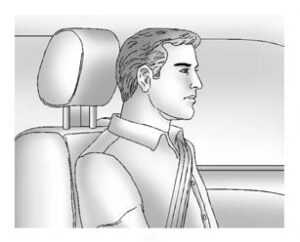
If equipped with base seats, adjust the head restraint so that the top of the restraint is at the same height as the top of the occupant’s head. This position reduces the chance of a neck injury in a crash
Front Seats
The vehicle’s front seats have adjustable head restraints in the outboard seating positions.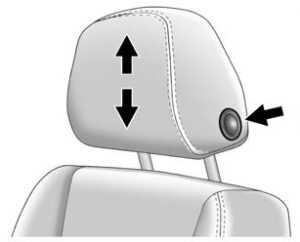
Adjust the head restraint so that the top of the restraint is at the same height as the top of the occupant’s head. This position reduces the chance of a neck injury in a crash. The height of the head restraint can be adjusted.
To raise or lower the head restraint, press the button located on the side of the head restraint, and pull up or push the head restraint down and release the button. Pull and push on the head restraint after the button is released to make sure that it is locked in place.
The front seat outboard head restraints are not removable.
Rear Seats
Second Row Seats
The vehicle’s rear second-row seats have adjustable head restraints in the outboard seating positions.
The height of the head restraint can be adjusted. Pull the head restraint up to raise it. Try to move the head restraint to make sure that it is locked in place.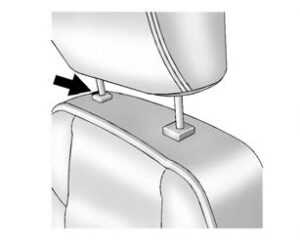
To lower the head restraint, press the button, located on the top of the seatback, and push the head restraint down. Try to move the head restraint after the button is released to make sure that it is locked in place. Rear outboard head restraints are not removable.
Front Seats
Power Seat Adjustment
Warning
You can lose control of the vehicle if you try to adjust the driver’s seat while the vehicle is moving. Adjust the driver seat only when the vehicle is not moving.
Warning
The power seats will work with the ignition off. Children could operate the power seats and be injured. Never leave children alone in the vehicle.

To adjust the seat:
- Move the seat forward or rearward by sliding the control forward or rearward.
- Raise or lower the seat by moving the rear of the control up or down.
- If equipped, raise or lower the front part of the seat cushion by moving the front of the control up or down.
For vehicles not equipped with front cushion tilt, the front part of the control will raise and lower the seat. If the vehicle is not in P (Park), seat travel may be limited. Release and press the seat switch again to continue the movement. To adjust the seatback, see Reclining Seatbacks 0 36.
To adjust the lumbar support, see Lumbar Adjustment 0 36. Some vehicles are equipped with a Safety Alert Seat. This feature activates a vibrating pulse alert in the driver’s seat to help the driver avoid crashes. Obstructions
If something has blocked the seat during movement, the movement may stop. Remove the obstruction and try the adjustment again. If movement is still not available, see your dealer.
Thigh Support Adjustment
If equipped, pull up on the lever. Then pull or push on the support to lengthen or shorten. Release the lever to lock in place.
Reclining Seatbacks
Warning
Sitting in a reclined position when the vehicle is in motion can be dangerous. Even when buckled up, the seat belts cannot do their job.
The shoulder belt will not be against your body. Instead, it will be in front of you. In a crash, you could go into it, receiving neck or other injuries. The lap belt could go up over your abdomen. The belt forces would be there, not at your pelvic bones. This could cause serious internal injuries. For proper protection when the vehicle is in motion, have the seatback upright. Then sit well back in the seat and wear the seat belt properly.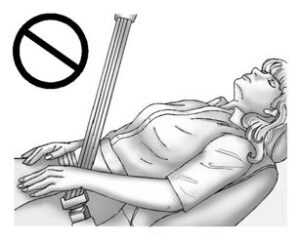
Do not have a seatback reclined if the vehicle is moving.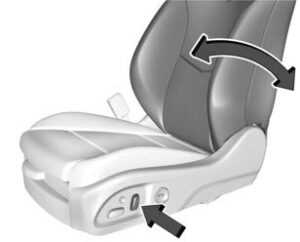
To adjust the seatback:
- Tilt the top of the control rearward to recline.
- Tilt the top of the control forward to raise.
Lumbar Adjustment
To adjust lumbar support, if equipped:
- If equipped, press Up (1) to move lumbar support upward.
- Press Rearward (2) to move lumbar support rearward.
- If equipped, press Down (3) to move lumbar support down.
- Press Forward (4) to move lumbar support forward
Up-level Lumbar Adjustment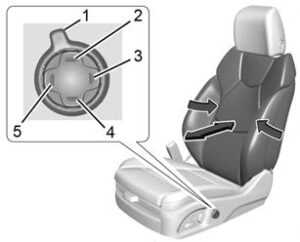
To adjust up-level lumbar support, if equipped:
- Press and release or hold Feature Select (1) to scroll to lumbar support on the infotainment display.
- Press Forward (5) or Rearward (3) to adjust the lumbar forward or rearward.
- Press Up (2) or Down (4) to adjust the lumbar up or down.
Bolster Support Adjustment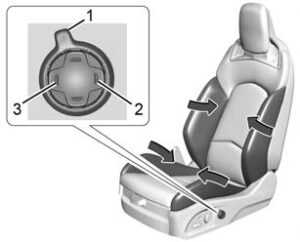
High-Performance Seat Shown, Others Similar
Back Bolster Support
To adjust back bolster support, if equipped:
Press and release or hold Feature Select (1) to scroll to bolster support on the infotainment display. Press Forward (3) or Rearward (2) to adjust back bolster support inward or outward.
Cushion Bolster Support
To adjust cushion bolster support if equipped:
Press and release or hold Feature Select (1) to scroll to bolster support on the infotainment display. Press Forward (3) or Rearward (2) to adjust cushion bolster support inward or outward.
Massage
equipped, the vehicle must be on to use the massage feature.
To activate and adjust massage:
- Turn the Feature Select (1) to scroll to massage on the infotainment display.
- Press Up (2) or Down (4) to adjust the massage type.
- Press Forward (5) or Rearward (3) to adjust the intensity.
- To turn the message off or to activate the massage at the last massage type and intensity settings, press the massage On/ Off Control (6).
The massage feature will turn off after approximately 20 minutes. Press the massage On/Off Control (6) to restart the massage feature.
Memory Seats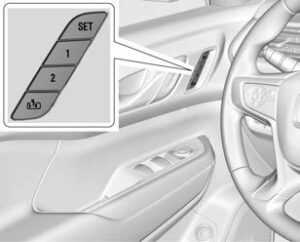
Overview
If equipped, the memory seat feature allows drivers to save their unique driving positions and a shared exit position. See “Saving Seating Positions” later in this section. The saved positions can be recalled manually by all drivers, see “Manually Recalling Seating Positions” later in this section, and drivers with remote key 1 and 2 can also recall them automatically. See “Auto Seat Entry Memory Recall” or “Auto Seat Exit Memory Recall” later in this section. To enable automatic recalls, turn on Seat Entry Memory and/or Seat Exit Memory. See “Enabling Automatic Recalls” later in this section. The memory recalls may be canceled at any time during the recall. See “Cancel Memory Seating Recalls” later in this section.
Identifying Driver Number
The vehicle identifies the current driver by their remote key numbers 1–8. The current remote key number may be identified by Driver Information Center (DIC) welcome message, “You are driver x for memory recalls.” This message is displayed the first few times the vehicle is turned on when a different remote key is used. For Seat Entry Memory to work properly, save positions to the 1 or 2 memory buttons matching the driver number of this welcome message. To aid in identifying remote key IDs, it is recommended to only carry one remote key when entering the vehicle. Perform the following if the welcome message is not displayed:
- Move all keys and remote keys away from the vehicle.
- Start the vehicle with another remote key. A DIC welcome message should display indicating the driver number of the other remote key. Turn the vehicle off and remove the other key or remote key from the vehicle.
- Start the vehicle with the initial key or remote key. The DIC welcome message should display the driver number of the initial remote key.
Saving Seating Positions
Read these instructions completely before saving memory positions.
To save preferred driving positions to 1 and 2:
- Turn the vehicle on or to accessory mode. A DIC welcome message may indicate the driver number of the current remote key. See “Identifying Driver Number” previously in this section.
- Adjust all available memory features to the desired driving position.
- Press and release SET; a beep will sound.
- Immediately upon releasing SET, press and hold memory button 1 or 2 matching the current Driver’s remote key number
until two beeps sound. If too much time passes between releasing SET and pressing 1 or 2, the two beeps will not sound indicating memory position was not saved. Repeat Steps 3 and 4 to try again. - Repeat Steps 1–4 for the other remote key 1 or 2 using the other 1 or 2 memory button.
It is recommended to save the preferred driving positions to both 1 and 2 if you are the only driver.
To save the common exit seating position to B that is used by all drivers for Manually Recalling Seating Positions and Auto Seat Exit Memory Recall features, repeat Steps 1– 4 using B, the exit button. Manually Recalling Seating Positions Press and hold 1, 2, or B button until the recall is complete, to recall the positions previously saved to that button. Manual Memory recall movement for 1, 2 or B buttons may be initiated and will complete to the saved memory position if the vehicle is in or out of P (Park).
Manually Recalling Seating Positions
Press and hold 1, 2, or buttons until the recall is complete, to recall the positions previously saved to that button.
Manual Memory recall movement for 1, 2 or buttons may be initiated and will complete to the saved memory position if the vehicle is in or out of P (Park).
If the manual transmission is equipped, Manual Memory recall movement for 1, 2, or B buttons may be initiated and will complete to the saved memory position if the vehicle parking brake is set or released.
Enabling Automatic Recalls
- Seat Entry Memory moves the driver seat to the selected 1 or 2 position when the vehicle is started. Select Settings > Vehicle
> Seating Position > Seat Entry Memory > ON or OFF. See “Auto Seat Entry Memory Recall” later in this section. - Seat Exit Memory moves the driver seat to the preferred exit position of the B button when the vehicle is turned off and the door is opened. Select Settings > Vehicle > Seating Position > Seat Exit Memory > ON or OFF. See “Auto Seat Exit Memory Recall” later in this section.
Auto Seat Entry Memory Recall
Seat Entry Memory will automatically begin a movement to the seating positions of the 1 or 2 button corresponding to the driver’s remote key number 1 or 2 detected by the vehicle when:
- The vehicle is turned ON.
- Seating positions have been previously saved to the same 1 or 2 buttons. See “Saving Seating Positions” previously in this section.
- Seat Entry Memory is enabled. See “Enabling Automatic Recalls” previously in this section.
- The vehicle is in P (Park).
- If a manual transmission is equipped, the parking brake must be set.
Seat Entry Memory Recall will continue if the vehicle is shifted out of P (Park) prior to reaching the saved memory position.
If a manual transmission is equipped, Seat Entry
Memory Recall will continue if the parking brake is released prior to reaching the saved memory position.
If the saved memory seat position does not automatically recall, verify the recall is enabled. See “Enabling Automatic Recalls” previously in this section.
If the memory seat recalls to the wrong position, the driver’s remote key number 1 or 2 may not match the memory button number positions they were saved to. Try the other remote key or try saving the positions to the other 1 or 2 memory buttons. See “Saving Seating Positions” previously in this section.
Automatic Seat Entry Memory recalls are only available for driver’s remote key numbers 1 and 2. Remote keys 3–8 will not provide Seat Entry Memory recalls.
Auto Seat Exit Memory Recall
Seat Exit Memory will begin a movement to the seating position of the B button when:
- The vehicle is turned off and the driver door is open or opened within a short time.
- A seating position has been previously saved to the B memory button. See “Saving Seating Positions” previously in this section.
- Seat Exit Memory is enabled. See “Enabling Automatic Recalls” previously in this section.
- The shift lever is in P (Park).
- If a manual transmission is equipped, the parking brake must be set.
Seat Exit Memory recall will continue if the vehicle is shifted out of P (Park) prior to reaching the saved memory position.
If a manual transmission is equipped, Seat Exit Memory will continue if the parking brake is released prior to reaching the save memory position.
Seat Exit Memory is not linked to the driver’s remote key. The seating position saved to Bis is used for all drivers.
Cancel Memory Seating Recalls
- During any memory recall:
Press a power seat control
Press SET memory button - During Manual memory recall:
Release 1, 2, or memory button - During Auto Seat Entry Memory Recall:
Turn vehicle off
Press SET, 1, 2, or B memory buttons - During Auto Seat Exit Memory Recall:
Press SET, 1, 2, or B memory buttons
Obstructions
If something has blocked the seat while recalling a memory position, the recall may stop. Remove the obstruction and try the recall again. If the memory position still does not recall, see your dealer.
Heated and Ventilated Front Seats
Warning
If temperature change or pain to the skin cannot be felt, the seat heater may cause burns. To reduce the risk of burns, use care when using the seat heater, especially for long periods of time. Do not place anything on the seat that insulates against heat, such as a blanket, cushion, cover, or similar item. This may cause the seat heater to overheat. An overheated seat heater may cause a burn or may damage the seat.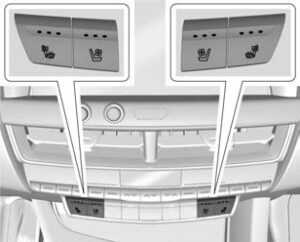
Auto Heated and Ventilated Seats
If the vehicle is equipped with auto-heated or ventilated seats, and the engine is running, this feature will automatically activate the heated or ventilated seats at the level required by the vehicle’s interior temperature. The active high, medium, low, or off-heated or ventilated seat level will be indicated by the manual heated and ventilated seat buttons on the center stack. Use the manual heated and ventilated seat buttons on the center stack to turn auto-heated or ventilated seats off. If the passenger seat is unoccupied, the auto-heated or ventilated seat feature will not activate that seat. If equipped with a heated steering wheel, the auto-heated steering wheel activation will follow the heated seat auto-activation and the heated wheel indicator will follow the state of the steering wheel heat.
To enable or disable auto-heated or ventilated seats, select Settings > Vehicle > Climate and Air Quality > Auto Cooled or Auto Heated Seats > ON or OFF.
Remote Start Heated and Ventilated Seats
During a remote start, the heated or ventilated seats, if equipped, can be turned on automatically. When it is cold outside, the heated seats will turn on followed by the heated steering wheel, if equipped. When it is hot outside, the ventilated seats turn on. The heated or ventilated seats are canceled when the ignition is turned on. Press the heated or ventilated seat button to use the heated or ventilated seats after the vehicle is started.
The heated or ventilated seat indicator lights do not turn on during a remote start. The temperature performance of an unoccupied seat may be reduced. This is normal. To enable or disable remote start heated or ventilated seats, select Settings > Vehicle > Remote Lock, Unlock, and Start > Remote Start Auto Heat Seats or Remote Start Auto Cool Seats > ON or OFF.
Rear Seats
Rear Seat Reminder
If equipped, the message REAR SEAT REMINDER LOOK IN REAR SEAT displays under certain conditions indicating there may be an item or passenger in the rear seat. Check before exiting the vehicle. This feature will activate when a second-row door is opened while the vehicle is on or up to 10 minutes before the vehicle is turned on. There will be an alert when the vehicle is turned off. The alert does not directly detect objects in the rear seat; instead, under certain conditions, it detects when a rear door is opened and closed, indicating that there may be something in the rear seat. The feature is active only once each time the vehicle is turned on and off, and will require reactivation by opening and closing the second-row doors. There may be an alert even when there is nothing in the rear seat; for example if a child entered the vehicle through the rear door and left the vehicle without the vehicle being shut off.
The feature can be turned on or off. Select Settings > Rear Seat Reminder > ON or OFF.
To adjust the seat position:
- Remove objects on the floor in front of or on the second-row seat, or in the seat tracks on the floor.
- Lift the lever below the seat cushion and slide the seat forward or backward.
- Push and pull on the seatback to ensure the seat is locked in place.
Folding the Seatbacks
Either side of the seatback can be folded for more cargo space. Fold a seatback only when the vehicle is not moving To fold the second-row seatbacks:
Caution
Folding a rear seat with the seat belts still fastened may cause damage to the seat or the seat belts. Always unbuckle the seat belts and return them to their normal stowed position before folding the rear seat.
To fold the seatback: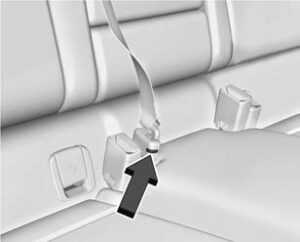
- Disconnect the rear seat belt mini-latch using a key in the slot on the mini-buckle, and let the belt retract.

- Pull the lever on top of the seatback toward you to unlock the seatback.
A red tab near the seatback lever raises when the seatback is unlocked. - Fold the seatback forward.
Repeat Steps 2 and 3 to fold the other seatback if desired.
Raising the Seatback
- Remove anything on or under the seat.
- Fold the head restraint rearward. See Head Restraints 0 35.
- Pull forward on the reclining seatback handle.
Warning
If either seatback is not locked, it could move forward in a sudden stop or crash.
That could cause injury to the person sitting there. Always push and pull on the seatbacks to be sure they are locked.
Warning
A seat belt that is improperly routed, not properly attached, or twisted will not provide the protection needed in a crash.
The person wearing the belt could be seriously injured. After raising the rear seatback, always check to be sure that the seat belts are properly routed and attached, and are not twisted.
To raise a seatback:
- Lift the seat back up. Make sure the center seat belt and latch do not get trapped behind the seat. Push the seatback rearward to lock it in place.
A red tab near the seatback lever retracts when the seatback is locked in place. - Push and pull the top of the seatback to be sure it is locked into position.
- Reconnect the center seat belt mini-latch to the mini-buckle. Do not let the belt twist.
- Pull on the center seat belt to make sure the mini-latch is secure.
- Repeat the steps to raise the other seatback, if necessary.
When the seat is not in use, it should be kept in the upright, locked position.
Q&A
- What are head restraints?
Head restraints are an integral safety feature in modern automobiles designed to minimize whiplash injuries during a rear-end collision. - What is the difference between headrests and head restraints?
Headrests and head restraints are often used interchangeably, but head restraints are designed to prevent whiplash injuries in the event of a collision, while headrests are designed primarily for comfort and support. - What are the head restraint features in the Cadillac CT5 2023?
The Cadillac CT5 2023 features adjustable head restraints for both the front and rear seats to provide greater comfort and support for passengers. - How many passengers can the Cadillac CT5 accommodate?
The Cadillac CT5 can comfortably seat five passengers. - What is the legroom in the rear seats of the Cadillac CT5 2023?
The CT5’s rear seats offer ample legroom, providing passengers with a comfortable seating position even during long journeys. - What is the headroom in the rear seats of the Cadillac CT5 2023?
The CT5’s rear seats also offer ample headroom, providing passengers with enough space to sit comfortably. - What is the Cadillac User Experience (CUE) infotainment system?
The Cadillac User Experience (CUE) is an advanced infotainment system that provides a suite of features, including Bluetooth connectivity, voice recognition, and smartphone integration. - What is the Bose premium sound system in the Cadillac CT5 2023?
The Bose premium sound system is a high-quality audio system that is available as an option in the CT5, offering excellent sound quality and a great listening experience. - What is forward collision warning?
Forward collision warning is a safety feature that warns the driver of an imminent collision with the vehicle in front. - What is automatic emergency braking?
Automatic emergency braking is a safety feature that automatically applies the brakes if the vehicle detects an imminent collision. - What is lane departure warning?
Lane departure warning is a safety feature that alerts the driver if the vehicle begins to drift out of its lane. - Does the Cadillac CT5 2023 come with rear-seat entertainment?
The Cadillac CT5 does not come with rear-seat entertainment as a standard feature, but it is available as an option. - Does the Cadillac CT5 2023 have heated rear seats?
The Cadillac CT5 comes with heated rear seats as an option, providing passengers with greater comfort during cold weather. - Does the Cadillac CT5 2023 have ventilated rear seats?
The Cadillac CT5 does not come with ventilated rear seats as a standard feature, but it is available as an option. - What is the starting price of the Cadillac CT5 2023?
The starting price of the Cadillac CT5 2023 varies depending on the trim level and options selected, but it typically starts at around $37,000.
Useful Links
View Full User Guide: Cadillac CT5 2023 User Guide
Download Manuals: https://www.cadillac.com/support/vehicle/manuals-guides


